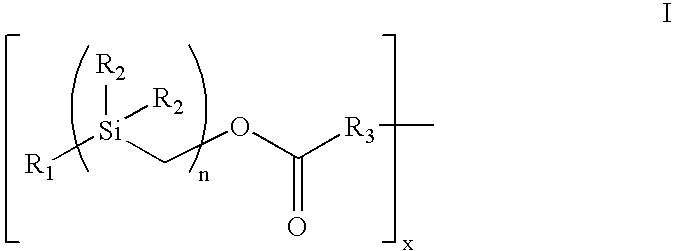Bioactive coating composition and methods
a technology of coating composition and biological activity, applied in the direction of packaging, pharmaceutical packaging, prosthesis, etc., to achieve the desired biological or therapeutic
- Summary
- Abstract
- Description
- Claims
- Application Information
AI Technical Summary
Benefits of technology
Problems solved by technology
Method used
Image
Examples
example 1
Method for Preparing Silyl-Heparin Covalent Complexes
[0098]Treatment of benzylmagnesium chloride 1 with chloro(chloromethyl)dimethysilane 2 gave benzyl(chloromethyl)dimethysilane 3 (n=1), all as shown in Scheme 2 below. Treatment of 3n with magnesium gave the Grignard Reagent, which was treated with chloro(chloromethyl)dimethyl-silane again to give the homologous silyl compound 3n+1. The Grignard reaction can be repeated over and over again to obtain the desired chain-length for the silyl compound. The chloro-silyl compound 3, on treatment with potassium acetate, followed by trans-esterification of the corresponding acetate with basified methanol gave the alcohol 4. The alcohol 4, when treated with triphosgene gave the corresponding chloroformate, which on treatment with N-hydroxy-succinimide gave the N-hydroxy-succinimidyl-carbonate 5. The conjugation of heparin with 5 was achieved by treatment of heparin with 5 and 4-(dimethylamino)pyridine in 1:1 DMF / H2O to give the silylated hep...
example 2
Techniques for Applying Silyl-Heparin Coating Compositions to Surfaces
[0105]The silyl-heparin complex of Example 1 was used as a coating solution as a 1% solution (w / v) in 60% aqueous ethanol. Materials were coated with silyl-heparin for 15 minutes at 37° C. The coated materials were then were rinsed extensively in water, air-dried, and stored until use.
[0106]In another embodiment, the silyl-heparin complex was dissolved in distilled water with gentle stirring, and an organic solvent added, such as isopropyl alcohol or acetonitrile, such that the organic solvent constituted approximately ⅔ of the volume, such as 100 mg of silyl-heparin complex of Example 1 solubilized in 27 mL of distilled water with gentle stirring, with 53 mL of isopropyl alcohol or acetonitrile then added, providing a resulting concentration of the silyl-heparin complex in solution of about 0.125%. In other embodiments, the resulting solution had a silyl-heparin complex concentration of between 0.01 and 10 percen...
example 3
Stability of Heparin Coating Compositions on Surfaces Exposed to Ionic Environments
[0107]Various surfaces coated according to Example 2 were evaluated for heparin activity after washing with 3% (by weight) sodium chloride solution. Surface heparin activity was measured in mlU / cm2 according to the technique described in Sigma Diagnostics, Heparin, Procedure No. CRS 106.
[0108]Results obtained from the evaluation of average heparin activity on various surfaces after washing with sodium chloride are set forth in Table 1 below. The concentration of the covalent complex in the coating solution was 0.25% (W / V).
[0109]
TABLE 1Percent by volume of isopropylalcohol in IPA / H20 solvent50%55%60%65%70%75%Material CoatedmIU of Heparin / Square CentimeterPOLYCARBONATE6.88.017.616.314.714.9TMCTS0.43.83.52.01.12.4POLYESTER4.54.45.53.75.3POLYVINYL CHLORIDE2.62.910.06.54.02.8STAINLESS STEEL12.913.18.311.012.913.8
PUM
| Property | Measurement | Unit |
|---|---|---|
| Fraction | aaaaa | aaaaa |
| Fraction | aaaaa | aaaaa |
| Fraction | aaaaa | aaaaa |
Abstract
Description
Claims
Application Information
 Login to View More
Login to View More - R&D
- Intellectual Property
- Life Sciences
- Materials
- Tech Scout
- Unparalleled Data Quality
- Higher Quality Content
- 60% Fewer Hallucinations
Browse by: Latest US Patents, China's latest patents, Technical Efficacy Thesaurus, Application Domain, Technology Topic, Popular Technical Reports.
© 2025 PatSnap. All rights reserved.Legal|Privacy policy|Modern Slavery Act Transparency Statement|Sitemap|About US| Contact US: help@patsnap.com



